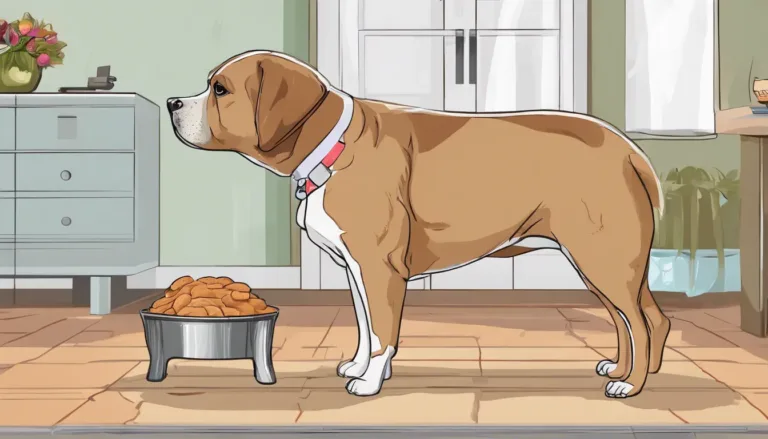In the realm of canine health, obesity stands as a burgeoning concern, with a significant percentage of dogs facing issues related to overweight conditions. This not only diminishes their quality of life but also predisposes these canines to a host of health problems such as diabetes, osteoarthritis, heart disease, and joint pain. Understanding the gravity of obese dogs’ plight is paramount for pet owners, as managing and improving their pet’s weight can lead directly to a happier, healthier, and potentially longer life. Employing a high-protein diet alongside weight loss foods specifically designed for canines, can significantly contribute to reaching and maintaining an ideal body weight, thus preventing obesity in dogs.
The article that follows offers a practical guideline for pet owners on combating obesity in their canine companions. Beginning with identifying if a dog is overweight, it proceeds to emphasize the importance of a comprehensive veterinary visit for a thorough nutritional assessment and crafting a personalized weight loss plan. Subsequent sections delve into gradually adjusting the dog’s diet to include the best weight loss food for dogs, implementing portion control, and embracing a high-fiber diet. Moreover, integrating an exercise routine is outlined as a cornerstone of effective weight management, underscoring its role in achieving optimal health outcomes. Coupling dietary modifications with regular physical activity, pet owners can embark on a proactive pathway toward restoring their dog’s health and mitigating the risks of complications like diabetes in dogs.
Helping Obese Dogs
Identify If Your Dog Is Overweight
Feel the Ribs
To determine if a dog is overweight, a simple rib check can be revealing. Owners should be able to feel their dog’s ribs without a thick layer of fat. The ribs should not be visible but should be easy to feel, similar to the back of a human hand [1]. If one has to press hard to feel the ribs, this is a sign that the dog may be carrying excess weight [2].
Look at the Body Shape
Observing the dog’s body shape from above and from the side can provide clear indicators of their weight condition. A healthy dog should have a visible waist when viewed from above and a tucked abdomen when viewed from the side [1]. If the dog appears oval-shaped from above, with no noticeable waist and a belly that hangs at the same level as the chest, it suggests that the dog is overweight [2]. An ideal body shape is more hour-glass, with a noticeable tuck-up from chest to stomach [1].
Check Endurance and Energy Levels
Overweight dogs often exhibit lower energy levels and endurance. They may pant excessively during walks or move more slowly than expected for their age and size [1]. If a dog is reluctant to move, tires easily, or sleeps more than usual, these could be signs of excess weight impacting their overall health and fitness [2]. Observing these behaviors can help owners recognize the need for a weight assessment and potential adjustments in diet and exercise [1].
Visit the Veterinarian
Health Check-up
Visiting the veterinarian annually is crucial for maintaining your dog’s health, especially if they are overweight. These regular check-ups allow the vet to detect early signs of potential health problems and provide an opportunity to keep vaccinations up-to-date [3]. During these visits, the veterinarian will conduct a thorough examination, which includes checking the heart, lungs, abdomen, skin, eyes, and ears. They will also ensure the microchip is functioning correctly [3]. Regular visits not only help in early disease detection but also get your dog accustomed to the vet’s office, making it less stressful for them [3].
Medical Conditions
Obesity in dogs can lead to or exacerbate various medical conditions. Common issues include type 2 diabetes, heart disease, osteoarthritis, and even certain types of cancer [4]. During the check-up, the veterinarian will assess for these conditions and may recommend diagnostic tests like blood work or urine analysis to rule out diseases like hypothyroidism or Cushing’s disease, which can contribute to weight gain [4]. Early detection and management of these conditions are crucial to prevent them from becoming severe [5]. Helping Obese Dogs
Dietary Recommendations
Addressing dietary needs is a fundamental part of managing your dog’s weight. The veterinarian will perform a nutritional assessment and recommend a diet plan tailored to your dog’s specific needs [4]. This might include a high-protein diet or a high-fiber diet to aid in weight loss while ensuring your dog receives all the necessary nutrients [3]. Portion control is vital, and your vet can help determine the exact amount of food your dog should consume daily [6]. Regular follow-ups are essential to adjust the diet plan based on your dog’s progress and any changes in their health status [4]. Helping Obese Dogs
Gradually Adjust Diet
Measure Food Portions
Accurately measuring a dog’s food portions is crucial for effective weight management. Pet owners should use a standard 8-oz. measuring cup or a kitchen scale to ensure precise portions. This helps prevent overfeeding, which is a common contributor to obesity in dogs. For accuracy, it’s recommended to measure the food level with the cup’s rim or the appropriate measuring line and confirm the weight on scales. This consistency ensures the dog receives the exact amount of food as per the dietary recommendations [7] [8]. Helping Obese Dogs
Switch to Low-Calorie Foods
Introducing low-calorie foods into a dog’s diet can significantly aid in weight loss. Households typically have access to a variety of healthy dog treats and low-calorie foods that are beneficial for weight management. Foods like apple slices, green beans, and carrot sticks not only provide nutritional benefits but also satisfy a dog’s craving with fewer calories. It’s important to select treats that are free of additives and preservatives to maintain overall health [9]. Additionally, transitioning to a new diet should be gradual, mixing increasing proportions of the new food with the old to avoid digestive upset [4].
Limit Treats
To support weight loss, treats should not exceed 10% of a dog’s daily caloric intake. It’s essential to include the calorie count of treats in the dog’s total daily energy requirements. Surprisingly, many dog treats contain a high number of calories which can quickly add up. Offering low-calorie alternatives like raspberries, apples, or air-popped popcorn without butter or salt can provide a satisfying snack without compromising the diet plan. These treats not only keep calorie intake in check but also provide a way to reward dogs without derailing their weight loss efforts [10] [4].Helping Obese Dogs
Implement an Exercise Routine
Start Slow
For dogs that have been inactive or are obese, it’s crucial to start their exercise routine slowly to prevent strain and injury. A gentle introduction to physical activity can include short 5-minute walks, gradually building strength and stamina. These initial outings should be brisk to encourage a light sweat in the owner, indicating a moderate pace [11]. As the dog’s fitness improves, the duration of the walks can be increased to 10-20 minutes once or twice a day, focusing on maintaining a pace that elevates the heart rate sufficiently for weight loss [11].Helping Obese Dogs
Daily Walks and Play
Regular exercise is essential for weight management in dogs. Veterinarians often recommend incorporating multiple daily walks into a dog’s routine. Walking is particularly beneficial as it places less stress on the joints compared to more vigorous activities like running or jumping. Starting with 30 minutes of brisk walking five days a week can effectively aid in weight loss [11]. Additionally, engaging in play sessions using toys, balls, or squeaky toys can motivate dogs to move more while making the exercise session enjoyable. Aim for at least 10 to 15 minutes of active play twice daily to keep their energy levels up and support weight management [11].
Use Interactive Toys
Interactive toys are an excellent way to encourage physical activity and mental stimulation for dogs. Toys that require dogs to move, think, or solve puzzles to receive a reward can significantly enhance their overall activity levels. For example, treat-dispensing toys like the Kong Classic or Orbee-Tuff Strawberry can keep a dog engaged by challenging them to retrieve treats through physical effort. These toys not only promote exercise but also provide mental stimulation, which is crucial for a dog’s cognitive health. Incorporating such toys into daily playtime can help in burning extra calories and preventing boredom, which is often a cause of overeating [12].
Conclusion
Throughout this article, we have traversed the multifaceted journey of managing and improving the health of obese dogs, highlighting the essential role of dietary adjustments, regular veterinary check-ups, and an appropriate exercise regimen. The synthesis of high-protein and high-fiber diets, coupled with the strategic implementation of portion control and the switch to low-calorie foods, emerges as a pivotal approach towards facilitating weight loss. Furthermore, the gradual introduction of exercise, starting with brief walks and progressing to more sustained physical activity, is underscored as critical for enhancing a dog’s overall well-being and longevity.
By adhering to the practical guidelines provided, pet owners are equipped to embark on a transformative path that not only addresses the immediate concerns related to their canine companions’ overweight conditions but also serves to preemptively mitigate potential health issues. The significance of a collaborative relationship with veterinarians, who play a vital role in tailoring a dog’s weight loss plan to its unique needs, cannot be overstated. As we conclude, the collective insight from this discussion encourages a proactive stance towards obesity management in dogs, underlying a commitment to their health that transcends mere dietary adjustments and exercise routines, fostering a deeper bond between pets and their owners.
FAQs
What should I feed my overweight dog to help them lose weight?
To help your overweight dog shed pounds, consider feeding them a diet rich in fiber or high in water content. This allows you to serve a larger volume of food without increasing calorie intake. Foods to look for include those containing fiber-rich vegetables such as broccoli, cauliflower, celery, and green beans. Additionally, you can mix these low-calorie, high-fiber vegetables into your dog’s current meals.
How can I assist a severely overweight dog in losing weight?
To help an overweight dog slim down, first determine if your dog is indeed overweight. Once confirmed, consult with a veterinarian for guidance. Gradually reduce the size of your dog’s food portions and be precise in measuring their food. Minimize the number of treats you give them and try to make their meals more filling. Finally, increase their exercise routine progressively.
What is a common addition to a weight loss diet for obese dogs?
While your dog does not necessarily need supplements specifically for weight loss, certain additives can facilitate the weight loss process. As your dog starts losing weight, consider incorporating supplements such as glucosamine and chondroitin, which can ease exercise for overweight or older dogs. Helping Obese Dogs
What steps should be taken to increase the weight of a severely underweight dog?
To help an underweight dog gain weight, ensure they are fed a preferred brand of dog food more frequently, ideally at least two meals a day with an option for a third or fourth smaller serving. Choose food that is high in fat and protein. Supplement their diet with cooked sweet potato and pumpkin, and offer high-fat treats, especially before bedtime. Adding peanut butter to their food can also be beneficial.
References
[1] – https://www.animalhumanesociety.org/resource/how-tell-if-your-pet-obese-and-why-it-matters
[2] – https://www.vscot.com/site/blog/2021/02/15/overweight-dog-chart
[3] – https://www.purina.co.uk/articles/dogs/health/daily-care/vet-check-ups-for-dogs
[4] – https://vcahospitals.com/know-your-pet/creating-a-weight-reduction-plan-for-dogs
[5] – https://www.zoetispetcare.com/blog/article/regular-veterinary-check-ups
[6] – https://www.vet.cornell.edu/departments-centers-and-institutes/riney-canine-health-center/canine-health-information/obesity-and-weight-management-tips
[7] – https://www.dogster.com/dog-nutrition/how-to-measure-dog-food-portions
[8] – https://www.ethosvet.com/blog-post/7-tips-to-properly-calculate-your-dogs-meal-portions/
[9] – https://dogslim.com/articles/best-healthy-dog-treats.html
[10] – https://www.aspca.org/news/healthy-safe-snacks-help-your-pet-slim-down
[11] – https://www.diamondpet.com/blog/health/weight-management/boosted-activity-helps-overweight-dogs/
[12] – https://www.treehugger.com/how-can-i-help-my-dog-lose-weight-4860017
Dog Care

